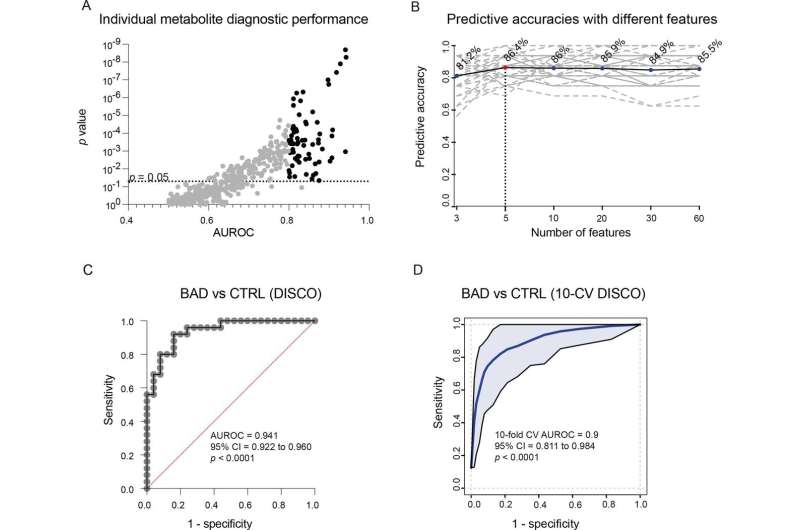This article has been reviewed according to Science X's editorial process and policies. Editors have highlighted the following attributes while ensuring the content's credibility:
fact-checked
peer-reviewed publication
trusted source
proofread
New method makes it easier to identify the right treatment for bile acid diarrhea

Most people have at some point in their life suffered an intestinal infection or food poisoning forcing them to stay close to the bathroom. It is very uncomfortable. Most of the time, though, it passes quickly.
But around 60,000-100,000 Danes suffer from a form of chronic diarrhea called bile acid malabsorption or bile acid diarrhea.
It is a chronic condition characterized by frequent and sudden diarrhea more than 10 times a day. Even though the disease is not life-threatening, it can seriously affect the patient's everyday life, especially their social life, and be extremely disabling.
"You have to rush to the bathroom several times a day. Therefore, keeping a job or maintaining social relations can be difficult, and a lot of people isolate themselves. The disease controls their life," says Professor Jesper Bøje Andersen from the Biotech Research & Innovation Centre.
He and his research group and clinical cooperation partners at Herlev and Gentofte Hospital headed by Professor and Consultant Doctor Filip Krag Knop are responsible for a new study, which provides new ways of diagnosing bile acid diarrhea and identifying the most effective treatment for the individual patient.
"A lot of people with chronic diarrhea don't realize that they suffer from bile acid diarrhea and what has caused it. This is a result of lack of knowledge among healthcare workers and the relatively complex and expensive—and for the patient difficult—process of diagnosing the disease," says Filip Krag Knop.
Jesper Bøje Andersen adds, "We have developed a new concept which may be used to diagnose the disease based on a simple blood sample. Today, diagnostics involves radiopharmaceuticals, which means that there is a radiation risk. The process is not necessarily dangerous, but unpleasant and arduous, and not all countries in the world support the method, including the US."
The new method means that doctors should be able to determine whether the patient has bile acid diarrhea based on a simple blood sample. They focus on molecules known as metabolites in the blood.
"A blood sample contains lots of different metabolites. Right now we are able to identify almost 1,300 different metabolites, and around a handful of these can be used to diagnose bile acid diarrhea. The metabolites of bile acid diarrhea patients form a particular pattern that makes them recognizable," says Jesper Bøje Andersen.
Which treatment?
The researchers analyzed blood samples from 50 patients and they quickly realized that the samples—and patients—could be divided into two groups.
"First, we did not understand why. All the blood samples had been taken before treatment, typically at the time of diagnosis," says Jesper Bøje Andersen.
The patients then participated in a randomized clinical study at the Center for Clinical Metabolic Research at Herlev and Gentofte Hospital. Here the doctors studied the effect of two different treatments: the conventional treatment involving bile acid sequestrant colesevelam and a new treatment involving liraglutide, which is normally used to treat type 2 diabetes and severe overweight.
"What is interesting is that the metabolites in the patients' blood divided them into two groups: one that responds well to colesevelam and one that responds well to liraglutide. This suggests that we should be able to say which treatment is the most effective by analyzing the patient's blood at the time of diagnosis," says Jesper Bøje Andersen.
The clinical study showed that colesevelam treatment eased the bile acid diarrhea symptoms of 50 percent of the patients, while liraglutide treatment eased the symptoms of 77 percent of the patients.
Jesper Bøje Andersen, Filip Krag Knop and their research groups hope the new study will benefit the 60,000-100,000 Danes who suffer from bile acid diarrhea.
The majority of cases of bile acid diarrhea is diagnosed at a very late stage or never diagnosed at all.
"Around 40 percent of the patients suffer from this condition for up to five years before it is diagnosed. Of course, this may be because they do not realize that it is a disease and that it can be treated. But it may also be because chronic diarrhea is a tabooed disease," says Filip Krag Knop.
The work is published in the journal Gut.
More information: Monika Lewinska et al, Serum lipidome unravels a diagnostic potential in bile acid diarrhoea, Gut (2023). DOI: 10.1136/gutjnl-2022-329213



















